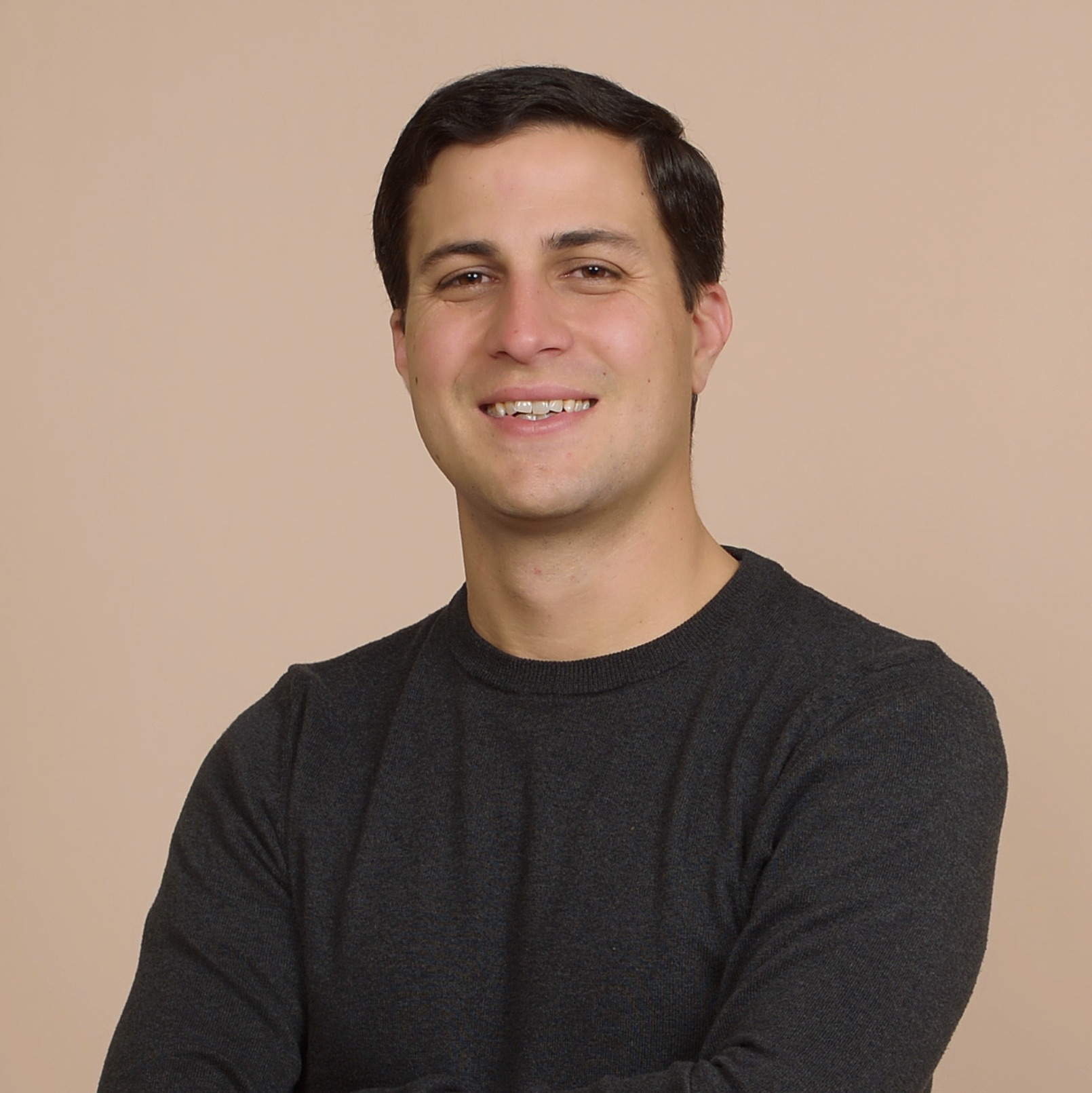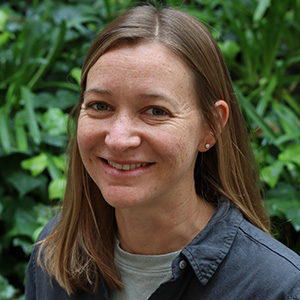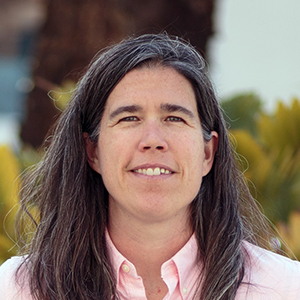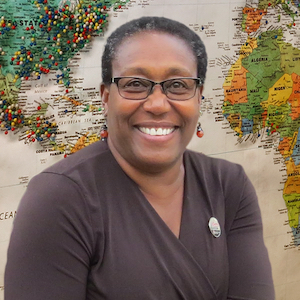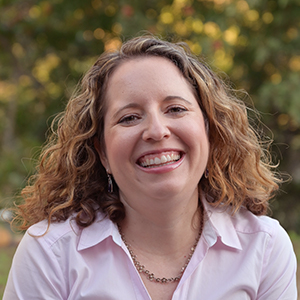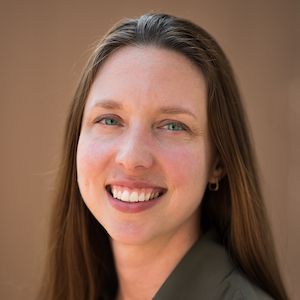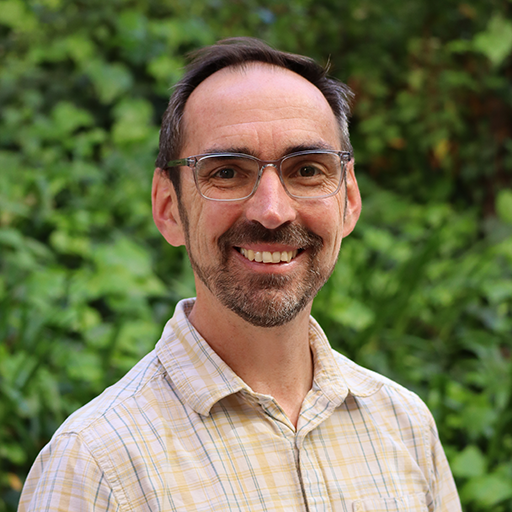Diversity, Equity, and Inclusion Plan
Diversity Council Members
Nicholas Barber, Ph.D. Associate Professor, Biology
Dr. Barber is an associate professor in the Biology Department at SDSU where he studies ecological communities of plants, insects, and microbes. Much of the work in his lab focuses on restored ecosystems to understand how habitats can be managed to protect biodiversity and benefit people. His goal as an educator and mentor is to ensure all students have the opportunity to succeed in the classroom, lab, and their careers. He is also chair of the Biology Department’s DEI Committee.
Heather Webb Instructional Support Technician, Geological Sciences
Heather Webb is an Instructional Support Technician in the Department of Geological Sciences. She is one of two co-facilitators of Show Me Geology, an elementary school outreach program that brings 2nd –4th graders to campus where they learn about earth processes. She works closely with geology faculty
and students to provide teaching, research, and field support.
Jillian Maloney, Ph.D. Associate Professor, Geological Sciences
Jillian Maloney is an associate professor of geological sciences. She researches earthquakes and landslides that happen underwater and natural resources in marine environments. She serves on the College and Department DEI committees and is a faculty advisor for the SDSU student chapters of the Association for Women Geoscientists (AWG) and Out in STEM (oSTEM).
Estralita Martin, Ph.D. Assistant Dean for Student Affairs
Dr. Estralita Martin, the assistant dean for student affairs for the College of Sciences, is a first-generation, African American from a low-income rural area in Missouri. She earned her bachelor’s degree in biology and physical education from Oberlin College, a master’s degree in biology at Atlanta University and her doctoral degree in cellular and developmental biology at the University of California, Berkeley. Dr. Martin understands well the struggles endured by students, particularly students from underserved communities, seeking a degree in one of the STEM disciplines and is committed to helping students acclimate to their collegiate community and become the research scientists, health professionals and science educators they envision for themselves.
Christal Sohl, Ph.D. Associate Professor, Chemistry & Biochemistry
The Sohl Lab strives to understand and combat cancer by probing mechanistic questions at the intersection of biochemistry, molecular biophysics, cell biology, and oncology. By understanding the molecular mechanisms of enzyme dysfunction, we can illuminate structure-function relationships, probe global cellular consequences of mutations, and identify new drug targets. A passion of Prof. Sohl’s is ensuring everyone has access to the scientific enterprise and feels supported in their participation — we simply cannot afford to leave behind talented future scientists!
Allison Vaughn, Ph.D. Professor, Psychology
Dr. Vaughn is a Professor in the Department of Psychology where she serves as the Faculty Advisor for the Psychology Club and Psi Chi (the international honor society in psychology). Her research examines social relationships, stigma, and health. As a first-generation transfer student, she knows the value of early research experiences for students’ success and persistence as she was a McNair Scholar as an undergraduate student. She also serves as the CoS Diversity Liaison on the SDSU Inclusion Council.
Bill Zahner, Ph.D. Associate Professor, Mathematics & Statistics
William (Bill) Zahner is an associate professor of the mathematics and statistics and the Director of the Center for Research in Mathematics and Science Education. His research focuses on improving mathematics teaching and learning for all students, especially multilingual students and students from historically marginalized communities that are underrepresented in STEM fields. Zahner’s interdisciplinary research team includes undergraduates, graduate students, and postdoctoral researchers, and his work has been supported through multiple grants from the National Science Foundation, the State of California, and private foundations.
Diversity Council Bylaws
(Update Spring 2025)
1. Committee Functions
1.1 The Diversity Council shall advise the CoS Dean on matters related to faculty, student, and staff diversity, equity, and inclusion.
1.2 The Diversity Council shall review and provide feedback on diversity plans developed by the CoS and its academic departments.
1.2 The CoS Dean may ask members of the Diversity Council to represent the CoS in University-level meetings and committees that concern matters related to diversity, equity, and inclusion.
2. Committee Membership
2.1 The committee shall consist of 5 tenured or tenure/tenure track faculty members, 1 lecturer, 2 staff members, and 2 students (one graduate and one undergraduate). The Dean will attempt to ensure that each academic department is represented by one non-student member.
2.2 The Dean will provide the committee’s charge at the first committee meeting of each academic year.
2.3 The terms of service of committee members who are not students shall be two years, with no limit to the number of consecutive terms served. Ordinarily terms shall be staggered so that at least three and no more than four tenure/tenure-track faculty members of the committee shall serve during the following year. The terms of service of student committee members may be one or two years.
2.4 Committee members shall be selected by the dean.
2.5 The chair of the Diversity Council shall normally be a faculty member, elected by committee members at the first committee meeting of each academic year. Nominations can originate from committee members or self-nomination. No release time is associated with this serving on this committee.
Diversity and Inclusion Plan
1. Unit Name
College of Sciences
2. Primary Contact Name
Teresa Couri
3. Primary Contact Email
4. Planning Committee Members
- Emilio Ulloa Ph.D. College of Sciences Director of Advising, Professor
- Jillian Maloney, Ph.D. Associate Professor, Department of Geological Sciences
- Rodrigo Navarro Perez, Ph.D. Assistant Professor, Department of Physics
- Estralita Martin, Ph.D. Assistant Dean, College of Sciences
- Teresa Couri, MBA, Budget Analyst & College of Sciences RTP Representative
- Christal Sohl, Ph.D. Assistant Professor, Department of Chemistry & Biochemistry
- Vanessa Malcarne, Ph.D. Professor, JDP Director, Department of Psychology
- Barbara Bailey, Ph.D. Associate Professor, Department of Mathematics and Statistics
- Jamie Rhine, Graduate Program Coordinator, Department of Biology
- Allison Vaughn, Ph.D. Associate Professor, Department of Psychology
- Tia Abusham, Undergraduate Student
- Sydney Spears, Undergraduate Student
- Brianne Palmer, Biology Ph.D. Student
- Alexandra Strom, Biology Undergraduate Student
- Deva Reign, Psychology Undergraduate Student
- Ryan Tung, Psychology Undergraduate Student
5. Process for Creation of the Diversity and Inclusion Plan
The process of creating the College of Sciences Diversity and Inclusion Plan began well before the COVID-19 pandemic and before the currently proposed budget cuts were anywhere on the horizon. This document was prepared as an aspirational and living document. As such, the committee set goals and objectives that are aggressive, while providing for annual assessments for monitoring our progress toward our goals and objectives and setting revised benchmarks, given the constraints of each academic year. We acknowledge that the current situation and possible future events will have implications on the plan, and adjustments can and should be made as the general situation evolves.
The College of Sciences has attempted to be inclusive of faculty, staff, and students in creating and finalizing the three goals for diversity and inclusion. Early on, faculty and staff were the focus but later in the planning process, it was apparent that we needed to include students (graduate and undergraduate) and their valuable thoughts and perspectives.
The College’s Diversity statement was drafted by the committee after reviewing several resources and statistics provided by the Division of Diversity and Innovation and as a result of extensive committee discussion. The discussion centered around defining Diversity for the purposes of this document, forming our collective views regarding the value of Diversity for the College, and developing our aspirations for the College in terms of Diversity and Inclusion.
Members of the planning committee analyzed college-level data on representation and faculty success in a planning institute hosted by the University’s Division of Diversity and Innovation. Furthermore, the university-level climate data from the Health Education Research Institute (HERI) survey as well as data collected from our own College of Sciences (CoS) faculty and staff were examined and presented in Section 6. The results of this environmental analyses were used to guide the creation of the three goals as well as the specific strategies to address each goal. The committee worked on the goals throughout Spring and Summer 2020, suggesting various strategies to implement the goals. A draft of the plan was shared with the Dean and the University Inclusion Council and their feedback was incorporated. The plan was then circulated to College and questions and concerns about the document from participating faculty and staff will be addressed at a townhall. Once again, feedback will be incorporated and the diversity planning committee will finalize the plan to be submitted to the University Diversity, Equity and Inclusion (DEI) Committee in October 2020.
The College of Sciences Diversity and Inclusion Plan was designed to be a living document to be reviewed and revised annually, based on changes that may arise from the changing nature of circumstances (ie., recommendations from the University Strategic Plan, changes to data, survey results, etc.) and reflective of the colleges commitment to continuously strive for improvement.
6. Diversity and Inclusion Statement
The SDSU College of Sciences (CoS) believes our strength is derived from the diversity of its faculty, staff, and students, along with their respective perspectives, experiences, and ideas. The CoS is further enriched by its location in the US-Mexico transborder region and its links to the broader Southern California community. We strive to create a community that supports and encourages the development and advancement of student leaders, staff, and faculty who invite and celebrate the ways that our differences can enhance the strength and rigor of our disciplines, and our research questions.
We define diversity broadly, and recognize that together we are better equipped to meet challenges with innovative and creative solutions, to educate and learn with curiosity and compassion, and to make impactful discoveries that advance our scientific understanding of the world. We encourage all members of our community to purposefully learn from one another through open and respectful dialogue and responsible engagement. We strongly preserve the right to free expression and encourage difficult conversations that help lead to improved individual and community learning and cohesion. Valuing and nurturing our unique and authentic identities is critical to harness the innovation and excellence that embracing our diversity and our differences may offer, and underpins our success.
7. Results from the Unit’s Environmental Assessment
Representation
Research suggests that more diversity amongst the faculty supports student success. Our faculty body does not represent our student body. Specifically, the College of Sciences is woefully underrepresented among the faculty with respect to Hispanic/Latinx, Black/African American, and Indigenous/Native American people.
From the Public Policy Institute of California, 39% of our state’s population is Latinx/Hispanic, 6% are Black/African American, and less than 1% are Native/Indigenous or Pacific islander. The SDSU student body overall is 29.9% Hispanic/Latinx and 29.1% in the College of Sciences, but Hispanic/Latinx make up only 6% Tenured/Tenure Track (T/TT) faculty within the CoS. The student body is 4% Black/African American, and 5% in the College of Sciences, but there is only one Black/African American T/TT faculty member within the CoS, which makes up only 0.6% T/TT faculty within the CoS. Over half of the student body in the College of Sciences (58.5%) identify as women (54.2% overall at SDSU), but only 28.9% of T/TT faculty in the CoS identify as women.
With regards to the staff, there are more women than men and, among the women, there are inequities with respect to Black/African American and Indigenous/Native American peoples.
Disproportionate Impact (DI) Ratios
Are calculated as: % Faculty representation divided by % Student representation. A ratio of less than 0.8 indicates a disproportionate impact.
For the CoS, the Disproportionate Impact Ratios of Faculty-to-Students based on Demographics are:
- Underrepresented Minority (URM): T/TT Faculty = 6.7%, Students = 34.7%, DI = 0.193
- Latinx: T/TT Faculty = 6%, Students = 29.3%, DI = 0.205
- Black/African American: T/TT Faculty = 0.6%, Students = 5%, DI = 0.120
- Native American/Pacific: Data on both students and T/TT faculty were not available in a reliable form for Native American analysis.
- Women: T/TT Faculty = 28.9%, Students = 58.5%, DI = 0.494
For the CoS, the Disproportionate Impact Ratios of Staff-to-Students based on Demographics are:
- URM: Staff = 19%, Students = 34.7%, DI = 0.548
- Female: Staff = 62%, Students = 58.5%, DI = 1.06
Note: Detailed demographics were not available for staff.
College of Sciences Faculty Representation Data
166 faculty (self-reporting)
- 1 = Black/African American
- 10 = Hispanic/Latinx
- 1 = Two or more ethnicities
- 24 = Asian
- 6 = did not report
- 124 = White
169 faculty (from Peoplesoft)
- Probationary: 25 male, 15 female
- Tenured: 96 male, 33 female
Climate
Data from the HERI climate survey indicated that climate for CoS faculty is overall satisfactory: if given the choice, over 74% agree they would still come to this institution, 74% agree their research is valued in their department, and 96% feel their teaching is valued in the department. Regarding diversity, when asked “institution has effective hiring practices and policies that increase faculty diversity” 68% of faculty respondents agreed (54% “somewhat agree” and 13% “strongly agree”). However, when asked “there is a lot of racial conflict on the campus” 82% of faculty agreed (40% “somewhat agree” and 42% “strongly agree”), and when asked “faculty are not prepared to deal with conflict over diversity in the classroom” 56% of faculty agreed (43% “somewhat agree” and 13% “strongly agree”).
Data from the climate survey indicated that climate for CoS staff is overall satisfactory: 56% agree that SDSU is perceived as a friendly place to work (44% “agree” and 12% “strongly agree”); however, only 33% percent of respondents feel valued at SDSU (27% “agree” and 6% “strongly agree”). This breeds some resentment and exacerbates a divide between faculty and staff.
When it comes to satisfaction among faculty, although feelings of having their contributions valued are high among the general population (38.2% “agree” and 26.7% “strongly agree”), when broken down by ethnic background the perception of being valued falls for members of URM groups (46% agree or strongly agree for URM vs 73% for non-URM). A similar divide arises by gender (62% agree or strongly agree for women vs 71% for men).
A small collective of CoS students from diverse backgrounds (including one graduate student) were recently invited to share their perspectives at a listening session hosted by the Dean and department chairs. These students expressed concern over a lack of representation among the faculty and staff, feeling that the curriculum was not inclusive or placed science information in any historical/social/political context. Students also think that faculty and Teaching Associates (TAs) are in need of diversity training.
Success
There doesn’t appear to be a major difference between demographic groups with regard to average years to full promotion. However, the overall pools for URM and female faculty are much smaller. The average time to promotion for URM faculty is 5.83 years with n = 6, while the average time to promotion for non-URM faculty is 5.96 years with n = 48. The average time to promotion for female faculty is 5.71 years with n = 14, while the average time to promotion for male faculty is 6.03 years with n = 60.
8. The Unit’s Goals for Diversity and Inclusion
Goal #1
Increase the representation of URM and women T/TT faculty and lecturers to better match student body demographics.
Goal #2
Improve climate among faculty and staff; specifically, increase employee satisfaction by 15% by race and gender.
Goal #3
Establish a climate and curriculum that emphasizes the role of diversity, equity, and inclusion with respect to race and gender as measured by climate surveys.
9. Planned Strategies and Interventions
Goal #1
Increase the representation of URM and women T/TT faculty and lecturers to better match student body demographics.
In service of Goal #1, the following strategies and interventions are proposed:
1. Require a certified Inclusion Representative on all search committees by the beginning of the Fall 2021 semester.
Develop the skills and tools necessary to be a resource for search committees in the college throughout all departments.
Resources Needed
- Time and training for Inclusion Reps.
Responsibility
- Department Chairs, Deans and Associate/Assistant Deans.
Assessment
- Records of Certifications from Inclusivity Representative.
2. Encourage and document attendance for Implicit Bias Training for all members of a faculty search committee by the beginning of the Fall 2021 semester.
Resources Needed
- Time for all members of CoS to complete training.
- Time for trainers to prepare and lead training sessions.
Responsibility
- Dean’s office to keep records of completed training.
- Division of Diversity & Innovation to organize training sessions.
Assessment
- % of women in the finalist pool and % of women students served by the school.
- % of URM in the finalist pool and % of URM students served by the school.
3. Enhance proportionality before starting the screening process when the applicant pool is not reflective of terminal degree holder demographics, beginning August 2021.
Resources Needed
- Time to review finalist pool.
Responsibility
- Committee Chair and Office of Employee Relations.
- Committee and Human Resources.
- Committee, Hiring Manager.
Assessment
- % of women in Interview pools and finalist pools compared to the % of women in available pools as designated by NSF PhD data.
- % of URM in Interview pools and finalist pools compared to the % of URM in available pools as designated by NSF PhD data.
4. Require that CoS finalists meet at least three Building on Inclusive Excellence (BIE) criteria, as of the date of release of this document.
Resources Needed
- Time to review finalist pool.
Responsibility
- Committee Chair and Office of Employee Relations.
- Committee and Human Resources.
- Committee, Hiring Manager.
Assessment
- Inclusion Representative and Chair of the Search Committee.
5. Investigate the possibility of including BIE criteria into the performance review process for T/TT faculty and lecturers by the end of the Spring 2022 semester. After the investigation has been completed, a new intervention MUST BE established by the College of Sciences Diversity and Inclusion Committee.
Resources Needed
- Time for inclusion council reps to do investigation of current policies and procedures.
Responsibility
- Inclusion council reps, deans and assistant/associate deans (eventually, department chairs).
Assessment
- Inclusion council reps will report back to the inclusion council on findings of investigation with suggestions for how to include BIE criteria into the performance review process.
- These recommendations will be shared with deans and assistant/associate deans.
Goal #2
Improve climate among faculty and staff; specifically, increase employee satisfaction by 15% by race and gender.
In service of Goal #2, the following strategies and interventions are proposed:
1. Establish regular town hall style College-wide staff meetings, once per semester, by April 2021. The Spring semester meetings should be conducted by April of the Academic Year and the Fall semester meetings should be conducted by October of the Academic Year.
With the goal to improve climate in the CoS, this intervention seeks to empower staff and provide the College with valuable information from the staff perspective.
Resources Needed
- Designate a CoS representative to facilitate meetings (Dean or Associate Dean).
- Technology for survey implementation and assessment.
- When held in person, space for holding the meetings.
- When held in person, snacks and coffee for meetings.
Responsibility
- Dean or Associate Dean.
Assessment
- Meeting attendance and minutes will be reviewed every academic year
- Confirm that suggestions made to CoS according to meeting minutes have been implemented.
- Climate survey should be repeated once a year to evaluate staff satisfaction compared to baseline after this intervention has been implemented.
2. Continue to hold regular town hall style College-wide faculty meetings, once per semester, by April 2021. The Spring semester meetings should be conducted by April of the Academic Year and the Fall semester meetings should be conducted by October of the Academic Year.
With the goal to improve climate in the CoS, this intervention, sometimes organized by rank (assistant, associate, full) and sometimes inclusive of all ranks, will seek to empower faculty and provide CoS with valuable information from the faculty perspective.
Resources Needed
- Designate a CoS representative to facilitate meetings (Dean or Associate Dean).
- Technology for survey implementation and assessment.
- When held in person, space for holding the meetings.
- When held in person, snacks and coffee for meetings.
Responsibility
- Dean or Associate Dean.
Assessment
- Meeting attendance and minutes will be reviewed every academic year.
- Confirm that suggestions made to CoS according to meeting minutes have been implemented.
- Climate survey should be repeated to evaluate faculty satisfaction compared to baseline after this intervention has been implemented.
3. Encourage and document attendance for speaker series on DEI issues (eg. implicit bias, social justice, worklife balance, etc.) by the beginning of the Fall 2021 semester.
Resources Needed
- Center for Inclusive Excellence (for faculty).
- Mentor & Coaching Success (for students).
Responsibility
- Department chair, variety of supervisors (direct supervisors for students).
Assessment
- Evidence of completion of various training.
4. Encourage and document attendance for all faculty and staff to receive implicit bias training by the beginning of the Fall 2021 semester.
With the goal to improve climate in the CoS, this intervention, sometimes organized by rank (assistant, associate, full) and sometimes inclusive of all ranks, will seek to empower faculty and provide CoS with valuable information from the faculty perspective.
Resources Needed
- Center for Inclusive Excellence (for faculty).
- Mentor & Coaching Success (for students).
Responsibility
- Department chair, variety of supervisors (direct supervisors for students).
Assessment
- Evidence of completion of various training.
Goal #3
Establish a climate and curriculum that emphasizes the role of diversity, equity, and inclusion with respect to race and gender as measured by climate surveys.
In service of Goal #3, the following strategies and interventions are proposed:
1. Establish regular town hall style College-wide student meetings, once per semester, by April 2021. The Spring semester meetings should be conducted by April of the Academic Year and the Fall semester meetings should be conducted by October of the Academic Year.
With the goal to improve climate in the CoS, this intervention seeks to empower students and provide the College with valuable information from the student perspective using themed town halls.
Resources Needed
- Designate a CoS representative to facilitate meetings (Dean or Associate Dean).
- Technology for survey implementation and assessment.
- Anonymous surveys before and at the town halls to give students an opportunity to share without speaking, with the option to give their name and contact information if they would like to discuss their response further. The surveys should include a single question for students to identify themselves as part of other minority groups, such as the LGBTQ+ community, first-generation college students, immigrants, people with disabilities, etc. to provide data for future DEI efforts.
- When held in person, space for holding the meetings.
- When held in person, snacks and coffee for meetings.
Responsibility
- Dean, Associate Deans, Assistant Dean.
Assessment
- Meeting attendance and minutes will be reviewed every academic year.
- Confirm that suggestions made to CoS according to meeting minutes have been implemented.
- Climate survey should be repeated once a year to evaluate student climate compared to baseline after this intervention has been implemented.
2. Add a course on equity, diversity, inclusion, and disparities in the sciences by the beginning of the Fall 2022 semester.
The creation of a comprehensive course in the sciences that reviews the historical context of the science being taught, addresses the intersection between diversity equity and scientific ethics, highlights the contributions of people of color to science, and directly addressing the issues of equity, inclusion, and diversity, this intervention seeks to increase the feelings of belonging among our student population from underrepresented groups in science.
Resources Needed
- Consultation with Center for Inclusive Excellence and Norah Shultz.
- Instructor to design/teach this class.
- Either through hiring or release time for current faculty to prep the class if hiring fails.
Responsibility
- Departments will include this course (these courses) in their curriculum as general education requirements at the appropriate level.
Assessment
- Tracking the creation of the course(s) in the short term.
- Tracking the effectiveness of the course(s) in the longer term.
3. Require the inclusion of equity/inclusion/diversity issues and contributions among the student learning outcomes in the syllabus in all CoS courses by the beginning of the Fall 2022 semester.
Either by reviewing the historical context of the science being taught, highlighting the contributions of people of color to science, or directly addressing the issues of equity, inclusion, and diversity, this intervention seeks to increase the feelings of belonging among our student population from underrepresented groups in science.
Resources Needed
- Online or printed resources.
Responsibility
- Department-level curriculum committees.
Assessment
- Department chairs and/or curriculum committees (or department-level diversity committees) need to read each syllabus of every course to ensure that this material is included.
4. Encourage and document attendance for DEI training of faculty and staff in the College of Sciences (major advisors, Health Professions Advising Office (HPAO) and CoS advisors, Supplemental Instruction (SI) instructors, TAs, lab coordinators, peer mentors in the CoS Success Center and HPAO) not otherwise captured in Goal #2, by the beginning of the Fall 2022 semester.
The interventions designed for these groups of people would be based off of the student climate survey.
Resources Needed
- Center for Inclusive Excellence (for faculty).
- Mentor & Coaching Success (for students).
Responsibility
- Department chair, variety of supervisors (direct supervisors for students).
Assessment
- Evidence of completion of various training.
5. The College of Sciences and all of its departments are responsible for developing a plan to increase student numbers in the CoS with respect to race and gender, through professional panels (like Careers in Sciences, Discover Your Dream) and outreach with student groups, CoS Student Council (CSSC), Educational Opportunity Program (EOP), Student Ability Success Center (SASC), Annual Biomedical Research Conference for Minority Students (ABRCMS), Society for Advancement of Chicanos/Hispanics and Native Americans in Science (SACNAS), etc. by the end of the Fall 2021 semester.
Resources Needed
- Time with each student group (within CoS) – using CSSC as a platform.
- Getting students involved in the clubs, Center for Advancement of Students in Academia (CASA) programs, etc.
- Faculty, staff, and students networking across campus groups outside of CoS (EOP, SASC, Cultural Centers, etc.).
Responsibility
- Dean, Associate Deans, Assistant Dean.
Assessment
- Compare the number of students that come in their freshman year as science majors to the number of students that graduate from CoS.
10. Accountability
To ensure accountability, we would strive to stagger/rotate membership off and on this committee so that an entirely new group does not have to start anew. Instead, there would be institutional memory from those members who remained. The goal then would be to set annual priorities or benchmarks and assess them to see how progress towards our three larger goals is coming given the constraints of each academic year.
Broadly, the CoS Diversity and Inclusion Committee (the Committee) will continue to meet regularly to monitor progress towards these goals:
- At the beginning of each Academic Year (AY), the Committee can help the Dean’s office solicit feedback from faculty, staff, and students about any climate or curricular concerns as a guide to help frame town halls and other interventions throughout the year.
- After each proposed college-wide student, staff, and faculty townhalls, the Committee can assess feedback obtained from participants for the annual report.
- At the conclusion of each AY, the Committee can discuss general progress toward the three larger goals as well as specific progress toward each intervention. They can summarize this information on an annual report for distribution to the CoS and give recommendations to the Dean regarding things such as search requests for the upcoming year and course offerings and scheduling.
